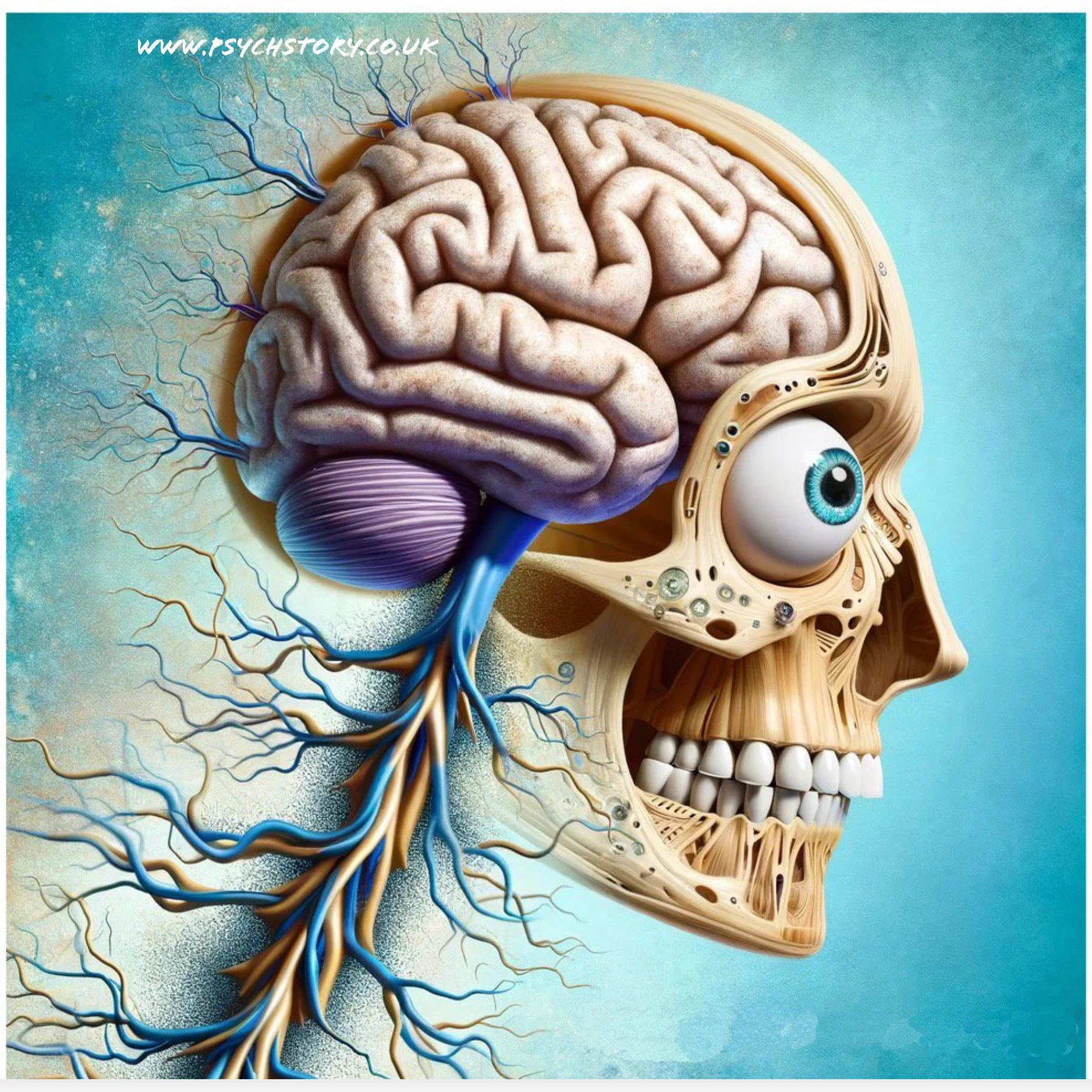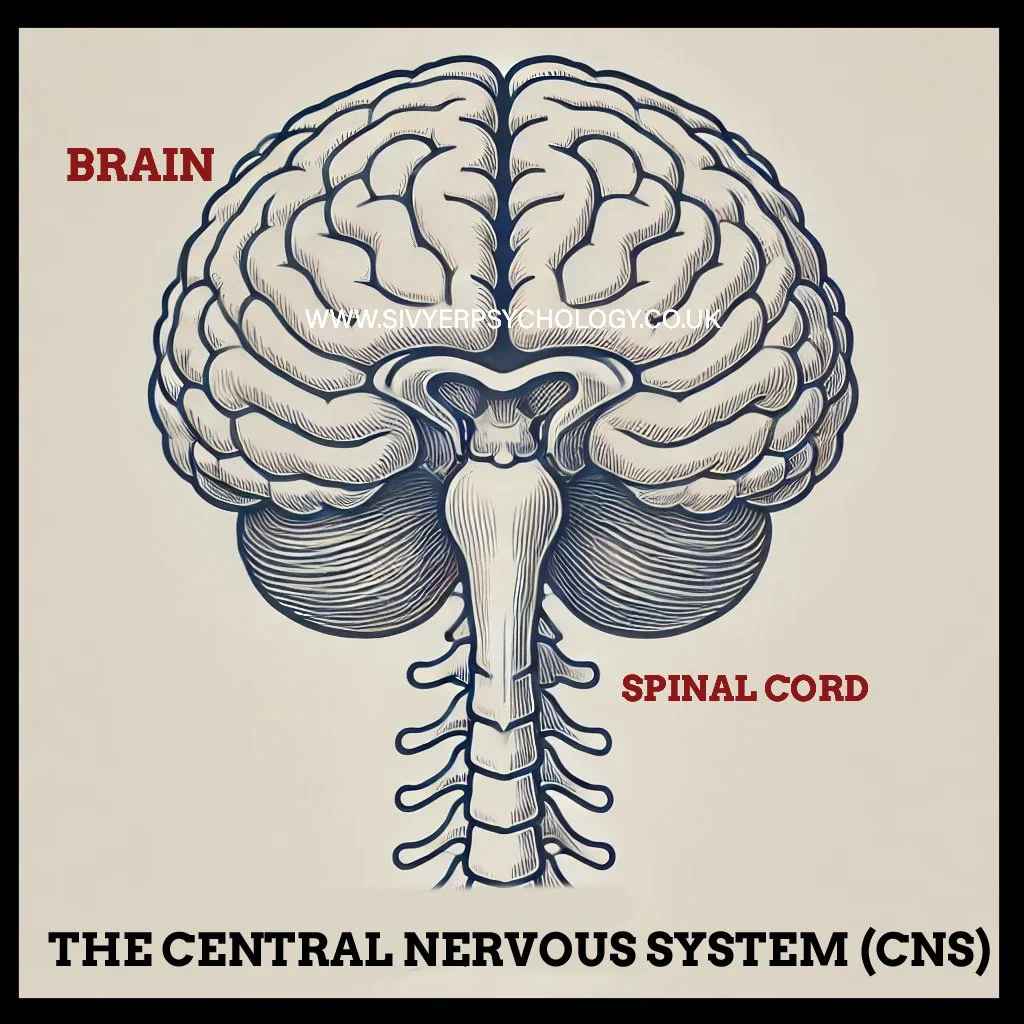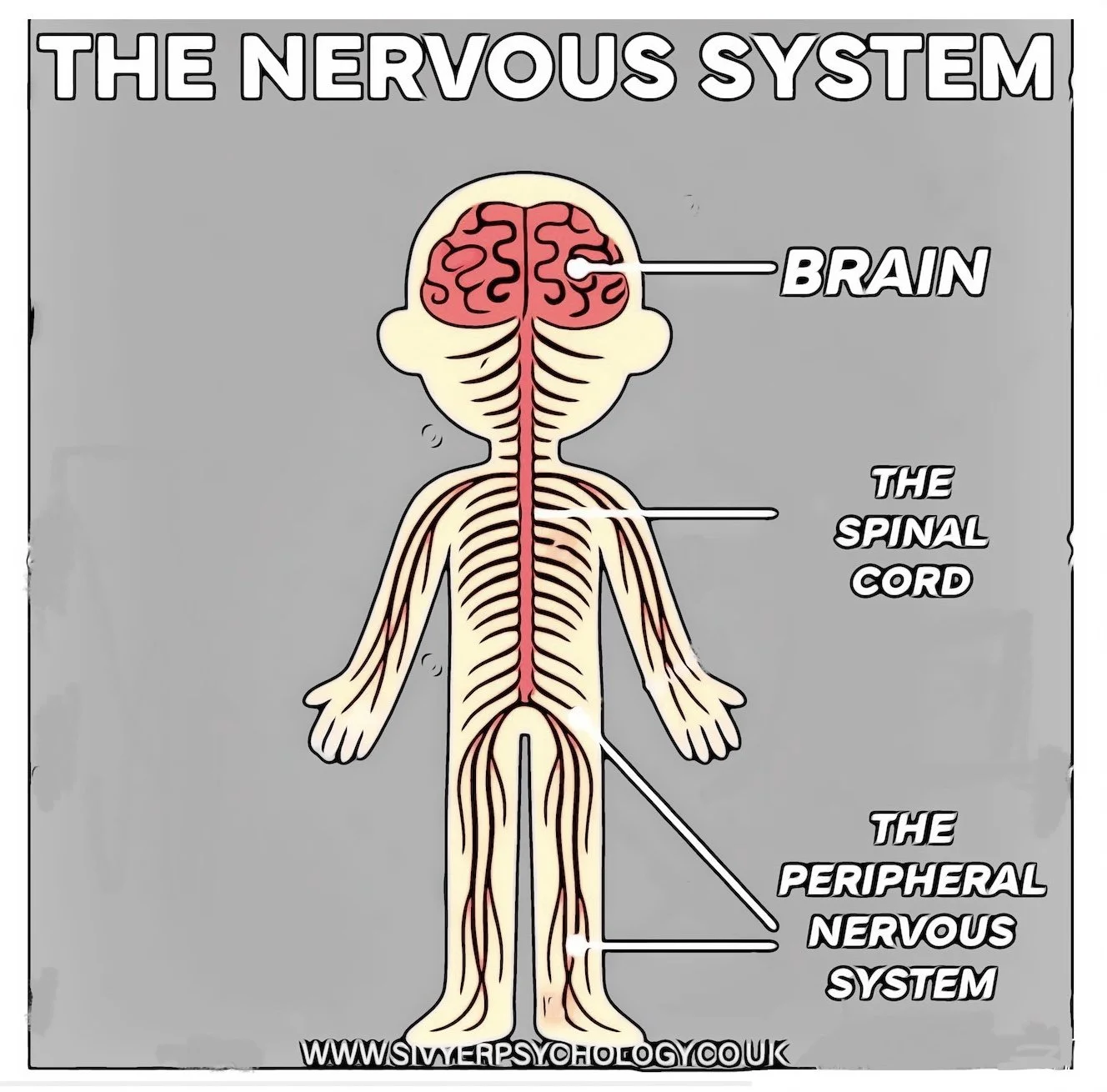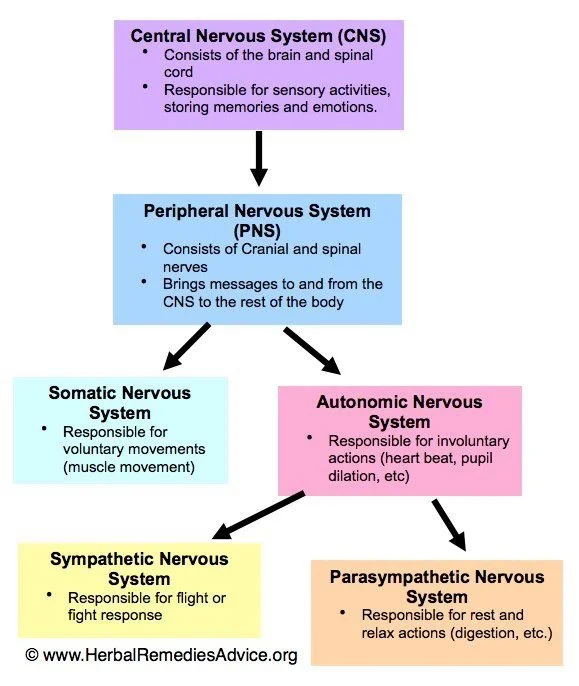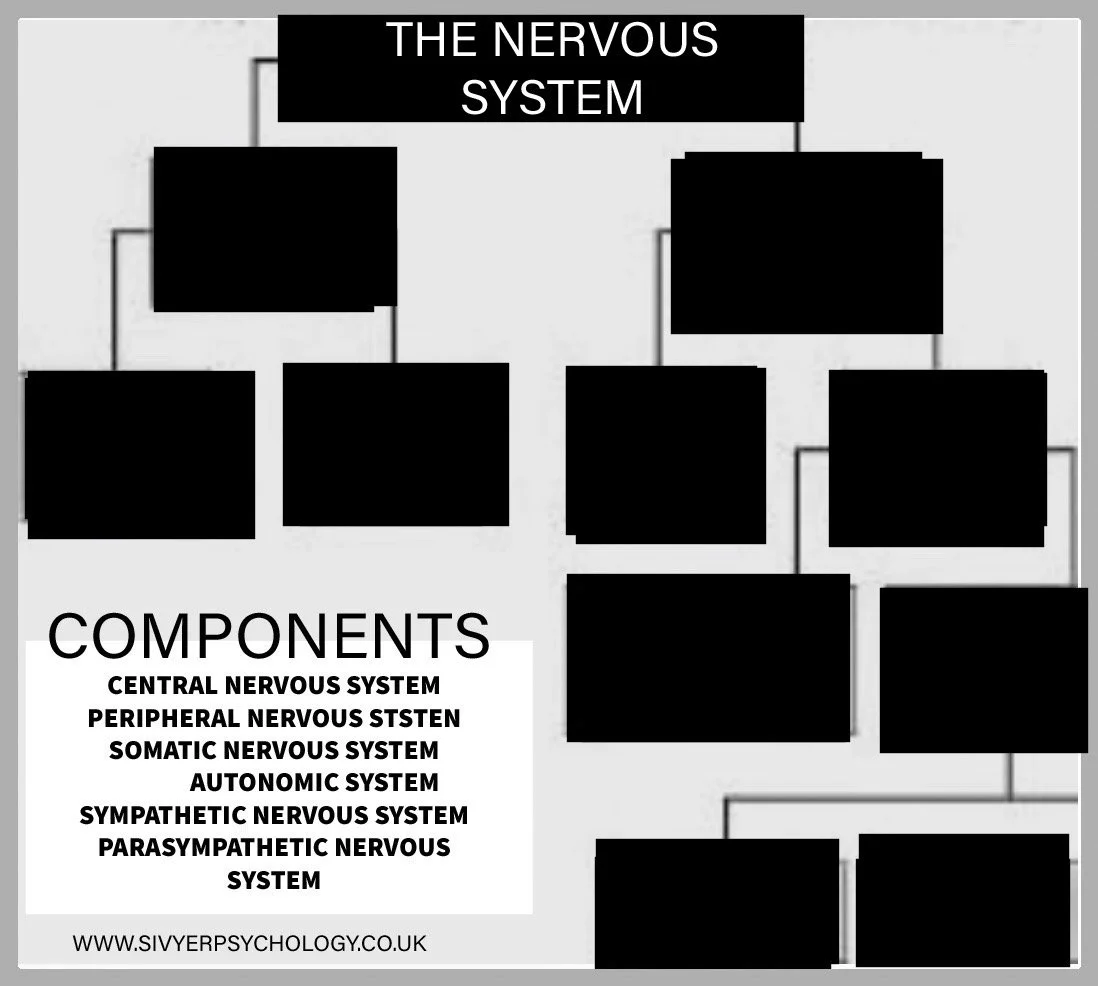THE NERVOUS SYSTEM
THE NERVOUS SYSTEMS
SPECIFICATION: THE DIVISIONS OF THE NERVOUS SYSTEM ARE CENTRAL AND PERIPHERAL - SOMATIC AND AUTONOMIC
The divisions of the human nervous system are central and peripheral (somatic and autonomic), and the basic functions of these divisions.
The autonomic nervous system and the fight or flight response. The James-Lange theory of emotion.
KEY TERMS
https://human.biodigital.com/gar/anatomy/female/nervous-system/
CNS (Central Nervous System): The central nervous system comprises the brain and spinal cord. It processes and integrates information, initiates responses, and controls most bodily functions.
Brain: The brain is the central control organ of the nervous system responsible for various cognitive, sensory, motor, and regulatory functions.
Spinal Cord: The spinal cord is a bundle of nerves that extends from the brain and runs down the back, serving as a communication pathway between the brain and the rest of the body.
PNS (Peripheral Nervous System): The peripheral nervous system comprises nerves and ganglia outside the central nervous system. It connects the CNS to the limbs and organs, facilitating communication between them.
Autonomic Nervous System (ANS): The autonomic nervous system regulates involuntary bodily functions such as heart rate, digestion, and respiration. It includes the sympathetic and parasympathetic divisions.
Somatic Nervous System (SNS): The somatic nervous system is responsible for voluntary muscle movements and sensory perception, allowing conscious control over actions like walking or talking.
Fight or Flight is a physiological response to stress or danger characterized by increased heart rate, heightened alertness, and other changes that prepare the body to confront or escape from a threat.
Adrenalin (Epinephrine): A hormone and neurotransmitter that plays a key role in the "fight or flight" response. It increases heart rate, dilates airways, mobilizes energy stores, and promotes glucose release.
Noradrenalin (Norepinephrine): Another neurotransmitter and hormone involved in the "fight or flight" response. It helps regulate heart rate, blood pressure, and the body's response to stress.
Glucose: A simple sugar and an essential source of energy for the body's cells. During the "fight or flight" response, the body releases glucose into the bloodstream to provide energy for immediate use.
INTRODUCTION
The best way to start with brain anatomy is with the most simplistic description, thus:
The brain is part of the nervous system.
The nervous system is split into two types:
The Central Nervous System (CNS)
The Peripheral Nervous System (PNS)
The brain is part of The Central Nervous System (CNS), including the spinal cord.
But what do we mean by nerves and the nervous system exactly? The nervous system is essential for life; we would not survive without it. It regulates everything from breathing and heart rate to complex thoughts and emotions. Damage to this system can lead to severe consequences, affecting our ability to move, sense, and think. The nervous system is the foundation of our identity and interaction with the world, making it crucial to our existence.
The human nervous system is an intricate web of nerve cells that transmit messages between the brain, spinal cord, and various body regions, facilitating seamless communication among all bodily components. At the helm of this intricate system is the brain, often described as the body's powerhouse despite comprising a mere 2% of its overall weight.
This remarkable organ is characterized by an astonishing network of billions of neural connections, intricately woven to enable the brain to govern the body's myriad functions. Notably, the brain assumes the role of a vigilant overseer, ensuring the smooth operation of bodily processes. Additionally, it houses higher functions that grant us consciousness and define our identities. The brain is the cornerstone of our existence, orchestrating the symphony of our biological and cognitive experiences.
THE CENTRAL NERVOUS SYSTEM (CNS)
The central nervous system (CNS) consists of the brain and spinal cord. The brain serves as the body’s control center, interpreting sensory information, making decisions, and sending instructions throughout the body. It processes everything from voluntary actions like walking to involuntary functions like heart rate and breathing.
THE BRAIN
The brain is a highly complex and vital organ located within the skull. It acts as the body's control centre, overseeing and coordinating various functions and processes. Without delving into specific brain structures, here's a more detailed description:
The brain is composed of billions of nerve cells known as neurons, which communicate with each other through electrical and chemical signals. It plays a crucial role in processing sensory information from the environment, regulating bodily functions, and enabling conscious experiences.
Some key functions of the brain include:
Cognition: The brain is responsible for various cognitive processes, including thinking, memory, problem-solving, decision-making, and language comprehension.
Emotion: It regulates emotions, influencing how we feel and respond to different situations. Emotional centres in the brain help control mood and emotional reactions.
Motor Control: The brain controls voluntary and involuntary muscle movements, allowing us to perform tasks, walk, talk, and engage in various activities.
Sensory Processing: It receives, interprets, and processes sensory information from the environment, such as sight, sound, touch, taste, and smell.
Homeostasis: The brain helps maintain the body's internal balance (homeostasis) by regulating functions like temperature, heart rate, blood pressure, and hormonal secretion.
Consciousness: It is responsible for our awareness and consciousness, allowing us to perceive the world, experience emotions, and have self-awareness.
Autonomic Functions: The brain controls vital autonomic functions, such as breathing, heart rate, digestion, and circulatory functions, often without conscious effort.
Overall, the brain is a multifaceted organ that plays a central role in our daily lives and is essential for our survival and well-being. It orchestrates an intricate symphony of activities that allow us to think, feel, move, and adapt to our ever-changing environment
SPINAL CORD FUNCTION
The spinal cord acts as an extension of the brain—essentially its "tail." Running down the back, it is a vital communication pathway between the brain and the rest of the body. Nerve signals travel up and down the spinal cord, allowing the brain to send commands to muscles and organs and receive sensory input from the body. The brain and spinal cord work in harmony to coordinate movement, reflexes, and automatic functions, making the CNS the central hub of all bodily operations
IN SHORT:
The spinal cord acts like a highway, transmitting signals between the brain and the rest of the body. It carries sensory information (like pain or touch) to the brain and sends motor commands from the brain to the muscles and glands.
It also controls reflex actions. Reflexes are automatic responses that don't need to be processed by the brain. For example, when you touch something hot, the spinal cord reacts immediately by making you pull your hand away before the brain processes the pain.
In cases where the spinal cord sustains damage, the regions of the body served by spinal nerves below the site of injury may become disconnected from the brain's control, leading to impaired or halted functioning in those specific areas. This underscores the critical role the spinal cord plays in facilitating essential bodily functions and reflexes.
PERIPHERAL NERVOUS SYSTEM (PNS)
. The term peripheral in everyday language refers to something that is on the edge or outskirts, rather than at the centre. For example, if something is on the periphery of a town, it means it's located on the outskirts or outer edges of the town, rather than in the centre.
In biology, the term works similarly. When we talk about the peripheral nervous system (PNS), it refers to the network of nerves that exist outside the central nervous system (CNS), which is made up of the brain and spinal cord. The PNS includes all the nerves that branch out from the spinal cord and brain to reach the rest of the body.
Thus. the peripheral nervous system (PNS) connects the CNS to the rest of the body.
CLOSED-LOOP SYSTEM: HOW THE CNS AND PNS WORK TOGETHER
The nervous system operates as a closed-loop system, meaning it constantly sends and receives information between the CNS and PNS in a continuous cycle:
Input: Sensory nerves in the PNS detect environmental changes (e.g., heat, pain, light) and send this information to the CNS.
Processing: The CNS processes the information and decides how the body should respond. For example, it may determine that you must move your hand away from a hot surface.
Output: The CNS sends signals to the muscles or glands through the PNS, instructing them to act (e.g., moving your hand away).
Feedback: The CNS monitors the body’s response to ensure the correct action is taken. This continuous communication helps maintain homeostasis—keeping internal conditions stable.
DIVISIONS OF THE NERVOUS SYSTEM
The peripheral nervous system (PNS) is divided into two parts:
The somatic nervous system
The autonomic nervous system
THE SOMATIC NERVOUS SYSTEM:
The somatic nervous system is responsible for controlling voluntary movements—those that are under conscious control. This system connects the brain to skeletal muscles, allowing us to move intentionally. For instance, when you decide to lift a cup or walk across a room, signals from the motor cortex in the brain travel through the spinal cord and nerves to the appropriate muscles to execute the action.
This system involves conscious and voluntary actions, meaning we are aware of and control these movements. It also processes sensory information from the skin, muscles, and joints, such as touch, temperature, and pain, sending this information back to the brain for interpretation.
The somatic system includes 12 cranial nerves that come straight from the brain and 31 spinal nerves from the spinal cord. These nerves do two main jobs:
Sensory Neurons carry messages from your body to your brain, so your brain knows what's happening around you.
Motor Neurons: These do the opposite. They take instructions from your brain and send them to different body parts, like telling your muscles to move when you want to walk or pick something up.
Motor neuron diseases, such as motor neuron disease (MND) or amyotrophic lateral sclerosis (ALS), directly affect the neurons that control voluntary movements. When these neurons degenerate, muscle weakness and difficulty controlling movements result.
THE NERVOUS SYSTEM
THE AUTONOMIC NERVOUS SYSTEM (ANS)
The autonomic nervous system (ANS) regulates involuntary, unconscious functions. These are the automatic processes in the body that we don’t consciously control, such as heart rate, digestion, respiratory rate, and blood pressure. The ANS ensures that these vital functions run smoothly without us having to think about them.
Unlike the somatic nervous system, which governs voluntary movements, the autonomic nervous system works behind the scenes, managing essential bodily functions without requiring our awareness or conscious effort
The ANS is divided into two branches:
THE SYMPATHETIC NERVOUS SYSTEM
THE PARASYMPATHETIC NERVOUS SYSTEM
The body cannot be in both sympathetic arousal and parasympathetic states at the same time. It shifts between the two systems depending on the situation, either preparing for action or returning to a state of rest
SYMPATHETIC NERVOUS SYSTEM (SNS)
This system is responsible for the fight-or-flight response.
FIGHT-OR-FLIGHT RESPONSE
The fight-or-flight response is a survival mechanism triggered by the sympathetic nervous system when encountering a threat or stressful situation.
When sensed, a threat alerts the amygdala, which then triggers the hypothalamus. The hypothalamus activates the body's fight-or-flight response by signaling the autonomic nervous system, particularly the sympathetic nervous system, to prepare the body for action. This results in physiological changes such as increased heart rate, heightened alertness, and the release of adrenaline
This response prepares your body for quick action:
Blood Pressure Increase: Sympathetic arousal causes blood vessels to constrict, which raises blood pressure. This is because it helps push blood more forcefully through your arteries, ensuring that vital organs receive enough oxygen and nutrients during times of stress or danger.
Heart Rate Increase: The sympathetic nervous system prompts your heart to beat faster and more forcefully. This ensures that your circulatory system can pump blood quickly to your muscles, brain, and other essential organs when needed for physical exertion or stress response.
Digestion Suppression: Sympathetic arousal slows down or temporarily suspends digestive processes. In a "fight or flight" situation, your body prioritizes sending resources and energy to areas like your muscles and brain rather than to digestion.
Saliva Suppression: Your mouth may become dry during sympathetic arousal because saliva production decreases. This helps conserve fluids in your body for other essential functions during stressful situations.
Urinary Function: The sympathetic nervous system reduces urine production by constricting the bladder and relaxing the urinary sphincters. This conserves fluids and energy during the "fight or flight" response.
Release of Bowels and Urine: In some cases of extreme stress, the sympathetic nervous system can trigger the release of bowels and urine. This is a natural response to make the body lighter for quick physical reactions.
Pupil Dilation: The pupils of your eyes dilate (widen) during sympathetic arousal. This allows more light to enter the eyes, improving your ability to see clearly and react to potential threats.
Secretion of Hormones: Sympathetic arousal prompts the adrenal glands to release hormones like adrenaline (epinephrine) and noradrenaline (norepinephrine). These hormones prepare your body for action by increasing alertness, energy, and focus.
Glucose Release: The liver releases stored glucose (sugar) into the bloodstream. This extra energy source is readily available for the body to use during times of heightened activity or stress.
Bronchial Dilation: The sympathetic nervous system causes the bronchioles in your lungs to dilate (expand), allowing for increased airflow. This ensures that your body receives enough oxygen to meet the demands of heightened physical activity.
Example: If you hear a sudden loud noise, the sympathetic system causes your heart to race, your muscles to tense, and your pupils to dilate, preparing you to react quickly to potential danger.
Once the threat has passed, the parasympathetic nervous system helps the body return to normal, slowing the heart rate, relaxing muscles, and restarting digestion.
PARASYMPATHETIC NERVOUS SYSTEM (PSNS)
THE PARASYMPATHETIC NERVOUS SYSTEM (PSNS)
This system promotes rest and digestion and helps maintain homeostasis, the body’s internal balance. It becomes active after a period of stress or heightened arousal, working to calm the body and restore its normal functions.
Once the threat has passed, the parasympathetic system works by:
Parasympathetic Nervous System Response:
Blood Pressure Decrease: The parasympathetic nervous system helps to lower blood pressure by relaxing blood vessels. This allows blood to flow more efficiently, reducing the strain on the heart and restoring calm after a stressful situation.
Heart Rate Decrease: The parasympathetic nervous system slows down your heart rate after stress or exertion. This brings your heart rate back to an average, restful pace, conserving energy.
Digestion Activation: Parasympathetic activation promotes digestion. It stimulates the digestive organs to resume their regular function, allowing the body to process food and absorb nutrients efficiently. This is often called the "rest and digest" response.
Saliva Production: In a calm state, the parasympathetic nervous system increases saliva production, which aids food digestion. This ensures that food can be broken down more effectively when you’re not under stress.
Urinary Function: The parasympathetic system relaxes the bladder, encouraging normal urination. Once the body is no longer in "fight or flight" mode, it restores urinary functions by promoting the elimination of waste.
Pupil Constriction: The parasympathetic nervous system causes your pupils to constrict (narrow), reducing the amount of light entering the eyes. This is part of the body’s return to a relaxed state, optimizing vision for normal, non-threatening conditions.
Hormonal Balance: Once the parasympathetic system is activated, it helps to counterbalance the effects of adrenaline and other stress hormones, allowing the body to return to a state of equilibrium and relaxation.
Glucose Storage: Instead of releasing glucose, the parasympathetic system signals the liver to store glucose as glycogen for future energy needs. This helps to restore balance after the body’s heightened energy use during stress.
Bronchial Constriction: The parasympathetic system causes the bronchioles in the lungs to constrict slightly, returning breathing to a slower and more regular rate. This ensures the body can maintain efficient oxygen levels in a relaxed state.
Example: After a stressful event, like giving a speech, the parasympathetic system works to calm your body. Your heart rate slows, digestion resumes, and your body gradually returns to a balanced, restful state
In essence, the parasympathetic nervous system restores equilibrium in the body, ensuring all systems function optimally, bringing the body back to its balanced state of homeostasis.
Example: After you’ve calmed down from a stressful situation, the parasympathetic system helps your body return to its normal state by slowing your heart rate and relaxing your muscles.
QUIZ
QUIZ: Somatic vs Autonomic Nervous System Functions
Indicate whether each function is primarily controlled by the Somatic Nervous System (S) or the Autonomic Nervous System (A).
Chewing food: (S/A)
Heart rate increasing during a stressful event: (S/A)
Kicking a football: (S/A)
Saliva production: (S/A)
Adjusting the focus of the eye for clear vision: (S/A)
Balancing while standing on one foot: (S/A)
Production of stomach acid for digestion: (S/A)
Shivering in cold temperatures: (S/A)
Typing on a keyboard: (S/A)
Blushing when embarrassed: (S/A)
Breathing rate changing while sleeping: (S/A)
Urinary bladder control: (S/A)
Smiling or frowning: (S/A)
Release of adrenaline during a fight-or-flight response: (S/A)
Maintaining posture: (S/A)
Regulation of blood glucose levels: (S/A)
Constricting blood vessels to regulate body temperature: (S/A)
Reacting to a sudden loud noise: (S/A)
Yawning: (S/A)
Blinking to keep the eyes moist: (S/A)
Indicate whether each function is primarily associated with Sympathetic Arousal (S) or Parasympathetic Arousal (P).
Increased heart rate: (S/P)
Stimulation of digestion: (S/P)
Dilation of pupils: (S/P)
Decreased heart rate: (S/P)
Constriction of airways: (S/P)
Stimulation of tear production: (S/P)
Increased sweating: (S/P)
Reduced urinary output: (S/P)
Relaxation of bladder muscles: (S/P)
Acceleration of metabolic rate: (S/P)
Constriction of blood vessels: (S/P)
Stimulation of saliva production: (S/P)
Slowing down of intestinal activity: (S/P)
Increased blood flow to muscles: (S/P)
Stimulation of gallbladder: (S/P)
Reduction of pupil size: (S/P)
Enhancement of blood clotting: (S/P)
Release of glucose from the liver: (S/P)
Relaxation of gastrointestinal tract: (S/P)
Promotion of genital arousal: (S/P)
QUESTION YOUR KNOWLEDGE
Put the components of the nervous system into the right boxes.
GCSE
EITHER: (2 marks)
Draw the diagram above and label it correctly
Name and put the term in the correct box.
Define the Central Nervous System (CNS). (2 marks)
Explain the primary functions of the CNS. (4 marks)
Describe the role of the spinal cord within the CNS. (3 marks)
What are the main components of the Peripheral Nervous System (PNS)? (2 marks)
Differentiate between the somatic nervous system and the autonomic nervous system within the PNS. (4 marks)
Provide an example of a reflex action controlled by the PNS. (2 marks)
Describe the structure and function of sensory neurons in the nervous system. (3 marks)
Explain the role of motor neurons in transmitting signals within the nervous system. (3 marks)
How does the somatic nervous system differ from the autonomic nervous system regarding neuron functions? (Additional 2 marks)
Define the sympathetic nervous system and the parasympathetic nervous system. (4 marks)
Compare and contrast the effects of the sympathetic and parasympathetic divisions on bodily functions during the "fight or flight" response and relaxation, respectively. (5 marks)
Outline the key divisions of the human nervous system. (3 marks)
Explain why the spinal cord is essential for reflex actions. (3 marks
A LEVEL
What is the main function of the human nervous system? (2 marks)
How does the nervous system facilitate communication between different parts of the body? (2 marks)
What is the approximate percentage of the body's weight that the brain represents? (1 mark)
Name the two main divisions of the human nervous system. (2 marks)
What are the components of the central nervous system (CNS)? (marks)
Explain the role of the spinal cord in the central nervous system. (2 marks)
What are the primary functions of the spinal cord? (2 marks) b. How does the spinal cord contribute to the coordination of voluntary movements? (2 marks)
What happens to bodily functions if the spinal cord is damaged below a certain point? (3 marks)
Name the four main areas of the brain. (2 marks)
Provide an example of a function associated with each of the four main areas of the brain. (4 marks) c. How do the two cerebral hemispheres communicate with each other? (2 marks)
What does the peripheral nervous system (PNS) consist of? (2 marks)
Differentiate between the somatic nervous system and the autonomic nervous system. (3 marks) c. What is the primary function of sensory neurons in the somatic nervous system? (2 marks)
Explain why the autonomic nervous system (ANS) is necessary for the body. (2 marks)
Name the two divisions of the ANS and describe their typical effects on bodily functions. (4 marks)
How do the sympathetic and parasympathetic divisions of the ANS differ regarding neurotransmitters and their effects? (3 marks)
Describe the primary functions of the sympathetic nervous system (SNS). (2 marks)
How does the SNS prepare the body to respond to emergencies? (3 marks) c. Explain the role of the parasympathetic nervous system (PNS) in relaxing the body. (3 mark.

